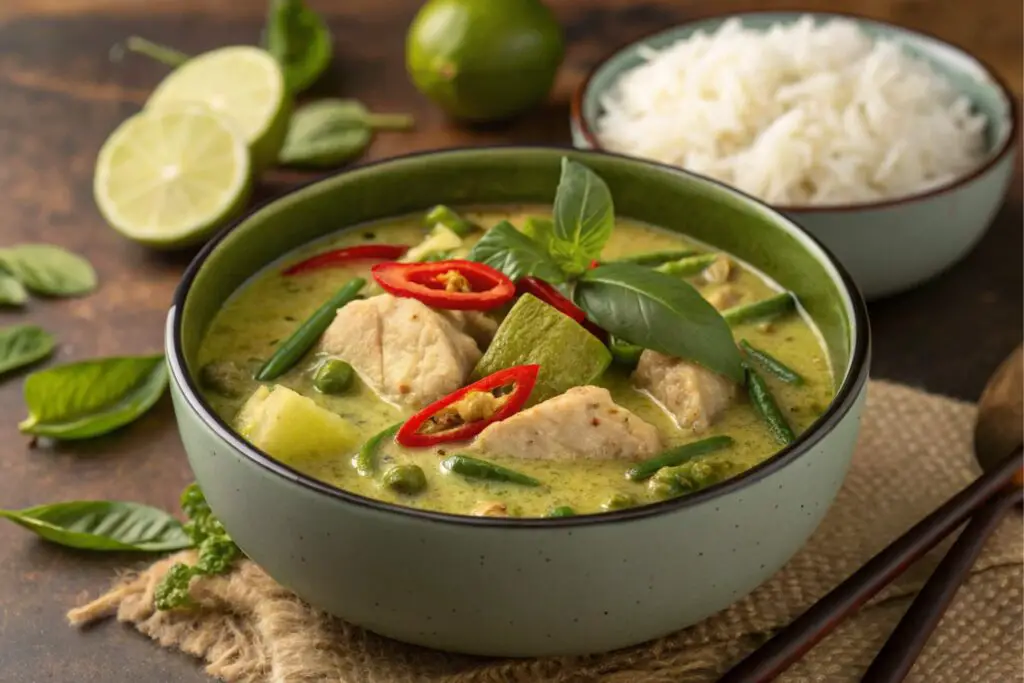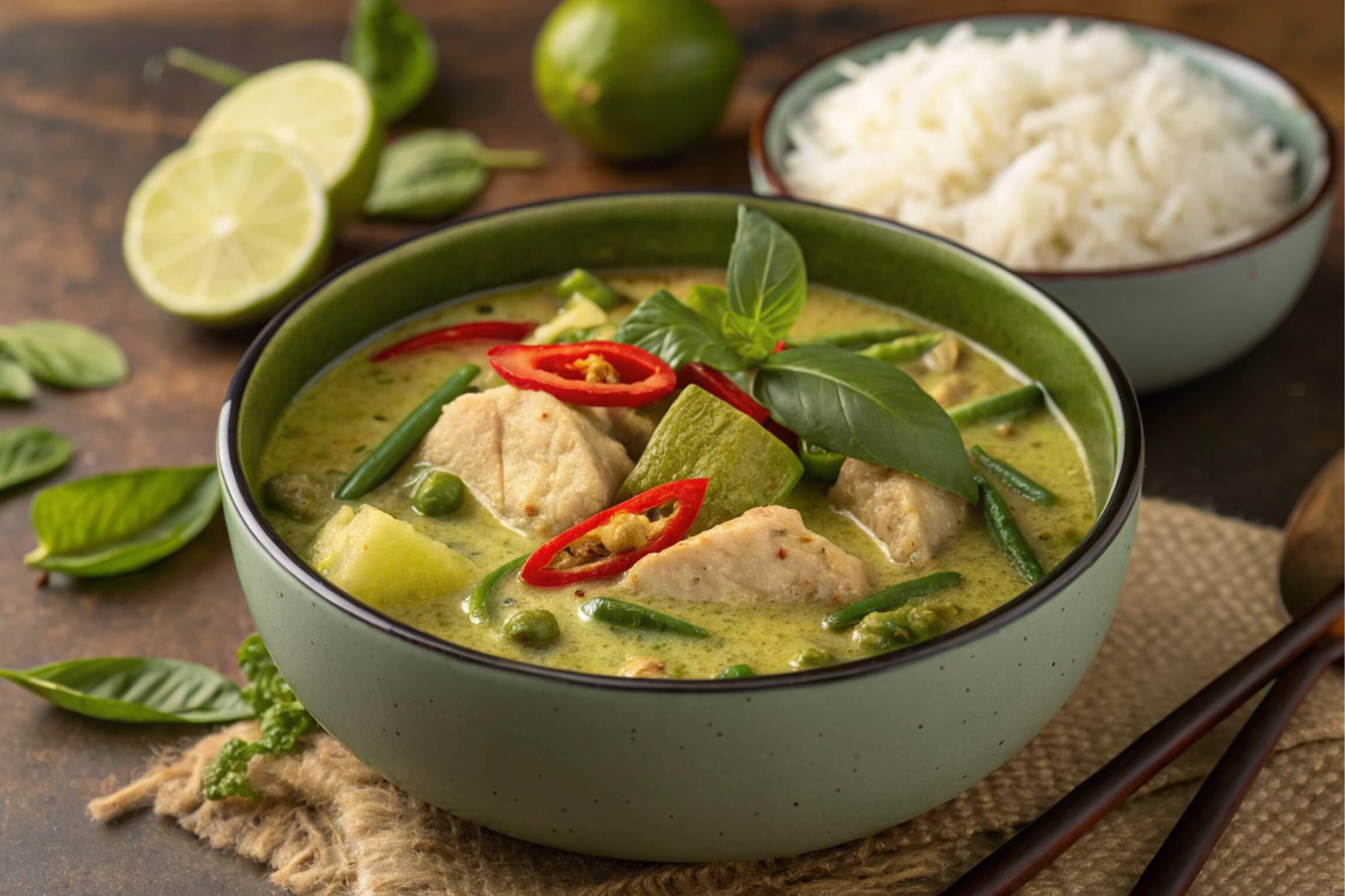want to listen to the recipe ?

Hi everyone! I’m so excited to share one of my all-time favorite recipes with you: Thai green curry. This dish is incredibly popular for good reason – it’s packed with amazing flavors, it’s fragrant, and it’s also easier to make at home than you might think. In this post, I’ll guide you through making a truly authentic and delicious green curry, using traditional techniques and ingredients. I think you’ll find it’s also quite flexible; you can easily change the protein and vegetables to suit your taste!
What is Thai Green Curry?
Thai green curry, or gaeng keow wan, is a classic dish from Thailand that features a unique flavor profile. It gets its distinctive taste mostly from fresh herbs and green chilies rather than dry spices. It’s important to know that green curry differs from Indian curries in both flavor and texture. Unlike the thicker stews you might associate with Indian cuisine, Thai green curry is traditionally more like a soup, with a light and broth-like consistency. Keep in mind, too, that this dish can vary depending on where you are in Thailand. I love how this dish can be both comforting and exciting at the same time!
Key Ingredients for an Authentic Green Curry
Let’s talk about the essential ingredients that you will need:
- Curry Paste:
- You can use either store-bought or homemade paste, but they do have different impacts on the recipe.
- If you go with store-bought, I recommend Maeploy, Aroy-D, or Maesri brands. These brands are much more flavorful and concentrated than others.
- Avoid Thai Kitchen brand; it’s very weak and will require much more to achieve the same taste.
- For the best flavor, try making your own paste! The recipe is included below. Extra paste freezes well.
- Coconut Milk:
- Use full-fat coconut milk for the best flavor and texture. Some brands separate more easily, and this is actually helpful in this recipe.
- Protein:
- Chicken thighs create the most delicious curry.
- You can also use chicken breast, but the method will be slightly different.
- Other good options include: tofu, seafood, or pork.
- Vegetables:
- Bamboo shoots are very common in green curry.
- Other options are Thai eggplant, winter melon, red bell peppers, potatoes, green beans, and mushrooms.
- Aromatics and Herbs:
- Makrut lime leaves are crucial for an authentic taste. You do not eat the leaves; remove them before serving. If you have dried leaves, use a few more since they are less flavorful.
- Thai basil provides a distinct flavor to the dish. You should add it at the end to keep its bright color and taste. If you can’t find Thai basil, regular basil can be substituted.
- You will also need fish sauce, palm sugar, and chicken stock (or vegetable broth for a vegan version).
- Other flavor enhancers: If you want to add some additional layers of flavor, consider ginger, cilantro, and cumin seeds.
[woo_product_slider id=”3030″]
Step-by-Step: Let’s Cook Thai Green Curry

Here’s how to make this amazing curry:
- Preparation: Before you start, get all your ingredients chopped and ready. If using chicken breasts, I suggest marinating them in fish sauce while you prep the rest.
- Reduce the Coconut Milk: In a pan, reduce ¾ cup of coconut milk until very thick. This step is important to bring out the flavor of the coconut milk. You will know it is ready when it has turned into a thick paste and the oil starts to separate from the coconut milk. It’s okay if the oil doesn’t separate, just keep reducing until it’s very thick.
- Sauté the Curry Paste: Add the curry paste to the reduced coconut milk. Sauté this mixture for a couple of minutes until it smells really good. If the paste starts to stick to the bottom of the pan, you can add a little more of the remaining coconut milk to deglaze it.
- Add the Protein:
- If using chicken thighs, add them to the paste and stir. Then add the rest of the coconut milk, chicken stock, makrut lime leaves, palm sugar, and fish sauce. Simmer for 10 to 15 minutes, or until the chicken is fully cooked.
- If you are using chicken breasts, add the kaffir lime leaves, coconut milk, chicken stock, palm sugar, and 1 tablespoon of fish sauce. Simmer for about 5 minutes. Then, add the marinated chicken breast and cook until it is 70% done, about 1 or 2 minutes.
- Add the Vegetables: Add your bamboo shoots and any other vegetables. If you’re using eggplant or winter melon, add those earlier in the process if you are using chicken breast. Simmer until the vegetables are tender.
- Simmer and Flavor: Let the curry simmer, letting the flavors blend. You want to make sure you infuse it with the makrut lime leaves. Then, season with fish sauce and palm sugar. Taste and make any final adjustments at this stage to your preference.
- Finishing Touches: Stir in the Thai basil and red pepper. Cook for only a very short time. If you like, you can squeeze some lime juice in as well.
Tips for the Best Thai Green Curry
Here are some tips I’ve learned along the way to help you make the perfect curry:
- Spice Level: You can control the spice by adjusting the amount of curry paste you use. If you make your own paste, you can remove the seeds from some of the chilies. You can also choose a milder store-bought brand.
- Texture: Remember, Thai green curry should be soupy. Avoid using light coconut milk, as this will make the curry thinner.
- Substitutions: If you cannot find makrut lime leaves or Thai basil, there are substitutes, but the flavor will change. For a vegan option, you can use soy sauce, salt, or vegan fish sauce instead of fish sauce.
- Troubleshooting:
- If your curry is too thin, be sure to use full-fat coconut milk and reduce the coconut milk for a longer time.
- If your curry lacks flavor, use a better quality curry paste, increase the amount of curry paste you use, or add more ginger or cilantro.
- If your curry is too sweet, use half the amount of sugar called for in the recipe.
- To remove the canned taste from the bamboo shoots, parboil them before adding them to the curry.
- If you make the curry too spicy, add more coconut milk, sugar, or both.
- Vegan/Vegetarian: It is very easy to adapt the curry for a vegan or vegetarian diet. Use tofu or vegetables instead of meat, vegetable broth instead of chicken stock, and soy sauce or salt instead of fish sauce.
- Serving: Serve your green curry with jasmine rice.
- Make Ahead: Both the curry paste and the curry sauce can be made in advance and frozen.
The Recipe: Green Curry Chicken
Yields: 4 servings
Prep time: 20 minutes
Cook time: 30 minutes
Ingredients:
- 1 ¾ cups (420 ml) coconut milk, divided
- 3 ½ Tablespoons (50 g) green curry paste, store bought or homemade
- 1 cup (240 ml) chicken stock, unsalted
- 1 lb (450 g) boneless, skinless chicken thighs, cut into 1-inch pieces
- 2 Tablespoons (24 g) finely chopped palm sugar or light brown sugar
- 1 ½ – 2 Tablespoons (22.5-30 ml) fish sauce
- 4 makrut lime leaves
- 1 550ml-can bamboo shoots strips, drained and rinsed
- 1 cup (22 g) Thai basil leaves
- ¼ red bell pepper, julienned
- Jasmine rice, for serving
Instructions:
- Reduce ¾ cup of coconut milk until thick and the coconut oil starts to separate.
- Add the curry paste and sauté for about 2 minutes until fragrant.
- Add the chicken thigh and stir to coat with the paste.
- Add the chicken stock, remaining 1 cup of coconut milk, palm sugar and 1 Tablespoon of fish sauce. Twist the makrut lime leaves to bruise and release their aroma, then tear them into chunks and add them to the pot. Discard the center stems.
- Simmer for 10 to 15 minutes, or until the chicken is fork tender.
- Add the bamboo shoots and bring to a boil. If you prefer your peppers to be more cooked, add them at this stage. Remove from heat.
- Taste and add more fish sauce or sugar as needed.
- Stir in Thai basil and red pepper.
- Serve with jasmine rice.
Homemade Green Curry Paste
(You can use the whole batch for the curry, but if you’re afraid it may be too spicy, hold back a bit and you can add more at the end. Any extra paste can be frozen.)
- 1 teaspoon (5 ml) cumin seeds
- 2 teaspoons (10 ml) coriander seeds
- ½ teaspoon (2.5 ml) white peppercorns
- 15 green Thai chilies (see note 4)
- 1 teaspoon (5 ml) coarse salt
- 15 Thai basil leaves, finely julienned
- 3 Tablespoons (45 ml) thinly sliced lemongrass, from bottom half only
- 1 Tablespoon (15 ml) finely chopped galangal
- 2 teaspoons (10 ml) makrut lime zest, finely chopped (or sub lime zest)
- 2 cilantro roots or 4 big cilantro stems, finely chopped
- 3 Tablespoons (45 ml) finely chopped shallots
- 2 Tablespoons (30 ml) finely chopped garlic
- 1 teaspoon (5 ml) fermented shrimp paste (gapi)
Instructions:
- Toast the cumin and coriander seeds in a dry sauté pan until aromatic, about 4 minutes. Cool on a plate.
- Grind toasted coriander seeds, toasted cumin seeds, and white peppercorns into a fine powder using a mortar and pestle. Remove from mortar and set aside.
- Cut at least 8 green Thai chilies in half horizontally and, with a paring knife, scrape off and discard the seeds and pith. Finely chop along with the remaining chilies. Note: Removing the seeds and pith will reduce the heat, you can remove seeds from all of the green chilies if you wish to tone it down even more.
- Add the chopped chilies and salt to a mortar and pestle; pound into a fine paste. If the mixture feels too wet at any point, add some of the ground spices to absorb the liquid.
- Add basil leaves; pound into a fine paste.
- Add lemongrass, galangal, kaffir lime zest, and cilantro roots; pound into a fine paste.
- Add shallots, garlic, and any remaining ground spices; pound into a fine paste.
- Add shrimp paste and pound to mix.
Notes
- If using chicken breasts, cut into ½-inch thick, bite-sized slices, and marinate in 2 teaspoons of fish sauce. Follow instructions specific to chicken breasts.
- Instead of bamboo shoots, you can substitute Thai eggplant cut into thin wedges (3 min cooking time), or winter melon, cut into 1-inch chunks (10 min cooking time).
- Ideally use Thai green chilies that are about 2 inches long, not the tiny ones.
Conclusion
Making Thai green curry at home is very achievable, and the results are absolutely delicious! I hope you’ll give this recipe a try and see for yourself. Don’t be afraid to experiment with different vegetables and proteins to find your favorite combinations. I’m excited for you to start cooking this at home and I would love to hear about your results!


